National symbols of France
| Part of a series on the |
| Culture of France |
|---|
| People |
| Mythology and folklore |
| Cuisine |
| Festivals |
| Religion |
| Music and performing arts |
| Sport |
National symbols of France are emblems of the French Republic and French people, and they are the cornerstone of the nation's republican tradition.
The national symbols of the French Fifth Republic are:[1]
- The French flag
- The national anthem: "La Marseillaise"
- The national personification: Marianne
- The national motto: Liberté, égalité, fraternité (Liberty, equality, fraternity)
- The national day: Bastille Day (celebrated on 14 July)
- The Gallic rooster
- The lictor's fasces emblem
- The Great Seal of France
Other French symbols include:
- The cockade of France
- The letters "RF", standing for République Française (French Republic)
- The National Order of the Legion of Honour and the National Order of Merit
- The Phrygian cap
- Joan of Arc
- Fleur-de-lis
- Bleuet de France, the symbol of memory for, and solidarity with, veteran, victims of war, widows, and orphans, similar to the Commonwealth remembrance poppy.
Flag
.svg.png)
The French flag is a tricolour that consists of three vertical stripes of equal width, coloured in royal blue, white, and red. It is the only official French emblem, according to article 2 of the current Constitution of France, adopted in 1958.
Fleur-de-lis
The fleur-de-lis, also spelled fleur-de-lys (plural fleurs-de-lis or fleurs-de-lys), is a common heraldic charge in the (stylized) shape of a lily (in French, fleur and lis mean 'flower' and 'lily' respectively). Most notably, the fleur-de-lis is depicted on the flag of Quebec and on the traditional coat of arms of France that was used from the High Middle Ages until the French Revolution in 1792, and then again in brief periods in the 19th century. This design still represents France and the House of Bourbon in the form of marshalling in the arms of Spain, Quebec, and Canada — for example.
Other European nations have also employed the symbol. The fleur-de-lis became "at one and the same time, religious, political, dynastic, artistic, emblematic, and symbolic", especially in French heraldry. The Virgin Mary and Saint Joseph are among saints often depicted with a lily.
Some modern usage of the fleur-de-lis reflects "the continuing presence of heraldry in everyday life", often intentionally, but also when users are not aware that they are "prolonging the life of centuries-old insignia and emblems". (Full article...)
-
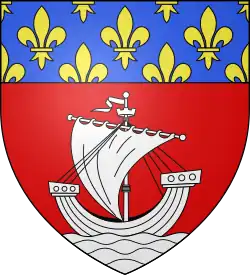 Coat of arms of Paris
Coat of arms of Paris -
.svg.png) Flag of France under the Capetian dynasty since the 12th century
Flag of France under the Capetian dynasty since the 12th century -
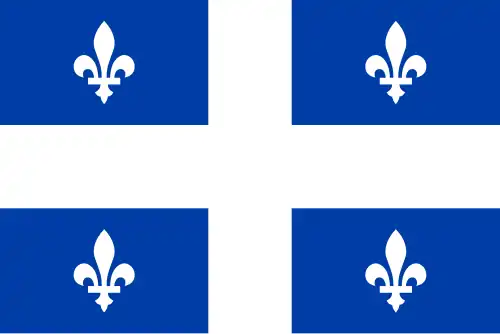 Flag of Quebec, paying homage to French symbols
Flag of Quebec, paying homage to French symbols
Anthem
"La Marseillaise" is the national anthem of France. It was written in 1792 by Claude Joseph Rouget de Lisle in Strasbourg after the declaration of war by the First French Republic against Austria, and was originally titled "Chant de guerre pour l'Armée du Rhin".
The French National Convention adopted it as the First Republic's anthem in 1795. The song acquired its nickname after being sung in Paris by Fédéré (volunteers) from Marseille marching to the capital. The anthem's evocative melody and lyrics have led to its widespread use as a song of revolution and its incorporation into many pieces of classical and popular music.
The Italian violinist Guido Rimonda pointed out in 2013 that the incipit of "Tema e variazioni in Do maggiore" of Giovanni Battista Viotti has a strong resemblance to the anthem. This incipit was first thought to have been published before La Marseillaise, but it appeared to be a misconception as Viotti published several variations of "La Marseillaise" in 1795 and wrote as a note "I have never composed the quartets below" (Je n'ai jamais composé les quatuors ci dessous). (Full article...)
Marianne
Marianne (pronounced [maʁjan]) has been the national personification of the French Republic since the French Revolution, as an emblem of liberty, equality, fraternity and reason, as well as a portrayal of the Goddess of Liberty.
Marianne is displayed in many places in France and holds a place of honour in town halls and law courts. She is depicted in the Triumph of the Republic, a bronze sculpture overlooking the Place de la Nation in Paris, as well as represented with another Parisian statue on the Place de la République. Her profile stands out on the official government logo of the country, and appears on French euro coins and on French postage stamps. She was also featured on the former franc currency and is officially used on most government documents.
Marianne is a significant republican symbol; her French monarchist equivalent is often Joan of Arc. As a national icon Marianne represents opposition to monarchy and the championship of freedom and democracy against all forms of oppression. Other national symbols of Republican France include the tricolor flag, the national motto Liberté, Égalité, Fraternité, the national anthem "La Marseillaise", the coat of arms, and the official Great Seal of France. Marianne also wore a Cockade and a red Phrygian cap symbolising Liberty. (Full article...)
Gallic rooster
The choice of the Gallic rooster as a symbol for France dates to the Middle Ages. It finds its origin in a play on the word gallus (Latin for rooster) and Gallus (Gallic). Despite its frequent use as a symbol for France, in particular by sports federations, the rooster has never been an official emblem. Cocorico! (French for 'cock-a-doodle-doo') is often used as an affirmation of French patriotism.
Great Seal
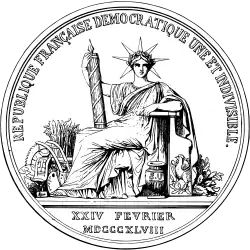
The Great Seal of France (French: Grand sceau de la République française) is the official seal of the French Republic. The seal features Liberty personified as a seated Juno wearing a crown with seven arches. She holds a fasces and is supported by a ship's tiller with a rooster printed on it. At her feet is a vase with the letters "SU" (Suffrage Universel', French for 'universal suffrage'). At her right, in the background, are symbols of the arts (painter's tools), architecture (Ionic order), education (burning lamp), agriculture (a sheaf of wheat) and industry (a cog wheel). The scene is surrounded by the legend RÉPUBLIQUE FRANÇAISE, DÉMOCRATIQUE, UNE ET INDIVISIBLE (French Republic, democratic, one and indivisible) and 24 FEV.1848 (24 February 1848) at the bottom.
The reverse bears the words AU NOM DU PEUPLE FRANÇAIS (In the name of the French people) surrounded by a crown of oak (a symbol of perennity) and laurel (a symbol of glory) leaves tied together with weed and grapes (for agriculture and wealth), and the circular national motto LIBERTÉ, ÉGALITÉ, FRATERNITÉ.
Diplomatic emblem
The diplomatic emblem of France is an unofficial emblem of the French Republic. It was adopted in 1913 by the French Foreign Ministry as a symbol for use by French diplomatic missions and consular posts abroad. It was based on an earlier design by the sculptor Jules-Clément Chaplain. The emblem also appears on the cover of French passports. (Full article...)
Coat of arms
France does not have an official coat of arms, but has an unofficial emblem. It depicts a lictor's fasces upon branches of laurel and oak, as well as a ribbon bearing the national motto of Liberté, égalité, fraternité. The full achievement includes the star and grand collar of the Legion of Honour. This composition was created in 1905 (during the Third Republic) by heraldic painter-engraver Maurice de Meyère, and it has been used at the Foreign Ministry during state visits and for presidential inaugurations.
The country is traditionally associated with the fleurs-de-lis design, which came into use by French kings during the High Middle Ages. This design still represents France and the House of Bourbon in the form of marshalling, such as in the arms of Spain, Quebec, and Canada. The fleur-de-lis was also the symbol of Île-de-France, the core of the French kingdom, and the arms of many French communes.
The only national symbol specified in the present constitution is the tricolour flag in Article 2. (Full article...)
Cockade
The cockade of France is the national ornament of France, obtained by circularly pleating a blue, white and red ribbon. It is composed of the three colors of the French flag with blue in the center, white immediately outside and red on the edge.
Other RF and tricolour-based emblems
-
 Shield on the Senate entrance
Shield on the Senate entrance -
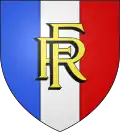 Sometimes used on a semi-official basis, but having no official status as the arms of the French Republic
Sometimes used on a semi-official basis, but having no official status as the arms of the French Republic
Historical emblems
1940–1944
-
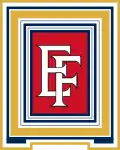
-
.svg.png) Unofficial
Unofficial
Emblem of Philippe Pétain, chief of state of the French State, featuring the motto Travail, Famille, Patrie (Work, Family, Fatherland). The Francisque was only Pétain's personal emblem but was also gradually used as the regime's informal emblem on official documents (Vichy France; 1940–1944). -
 Unofficial
Unofficial
Alternate version of the Francisque emblem of Philippe Pétain, chief of state of the French State -
_Cross_of_Lorraine.svg.png)
See also
References
- ^ "The symbols of the French Republic". Présidence de la République.